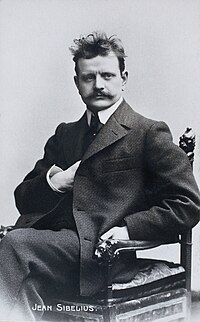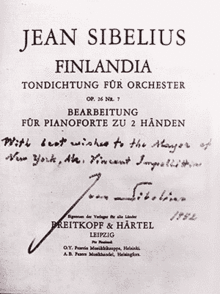Finlandia
| Finlandia | |
|---|---|
| Tone poem by Jean Sibelius | |
 The composer (c. 1900) | |
| Catalogue | JS 137/7 (original version) |
| Opus | 26 (revised version) |
| Composed | 1899, rev. 1900 |
| Publisher | Fazer & Westerlund (1901)[1][a] |
| Duration | 9 mins. (orig. 9 mins.)[3] |
| Premiere | |
| Date | |
| Location | Helsinki, Grand Duchy of Finland |
| Conductor |
|
| Performers | Helsinki Philharmonic Society |
Finlandia, Op. 26, is a tone poem by the Finnish composer Jean Sibelius. It was written in 1899 and revised in 1900. The piece was composed for the Press Celebrations of 1899, a covert protest against increasing censorship from the Russian Empire, and was the last of seven pieces performed as an accompaniment to a tableau depicting episodes from Finnish history.[6] The premiere was on 2 July 1900 in Helsinki with the Helsinki Philharmonic Society conducted by Robert Kajanus.[7] A typical performance takes between 7+1⁄2 and 9 minutes depending on how it is performed.
In order to avoid Russian censorship, Finlandia had to be performed under alternative names at various musical concerts. Titles under which the piece masqueraded were numerous and often confusing—famous examples include Happy Feelings at the awakening of Finnish Spring, and A Scandinavian Choral March.[citation needed] According to Finland's tourism website, "While Finland was still a Grand Duchy under Russia performances within the empire had to take place under the covert title of 'Impromptu'."[8]
Most of the piece is taken up with rousing and turbulent music, evoking the national struggle of the Finnish people. Towards the end, a calm comes over the orchestra, and the serene and melodic Finlandia Hymn is heard. Often incorrectly cited as a traditional folk melody, the Hymn section is Sibelius' own creation.[9]

Although he initially composed it for orchestra, in 1900 Sibelius arranged the work for solo piano.[7][10]
Sibelius later reworked the Finlandia Hymn into a stand-alone piece. This hymn, with words written in 1941 by Veikko Antero Koskenniemi, is one of the most important national songs of Finland. It has been repeatedly suggested to be the official national anthem of Finland.[11] Today, during modern performances of the full-length Finlandia, a choir is sometimes involved, singing the Finnish lyrics with the hymn section.[12]
With different words, it is also sung as a Christian hymn (I Sought The Lord, And Afterward I Knew; Be Still, My Soul,[13] When Memory Fades,[14] I Then Shall Live,[15] Hail, Festal Day, in Italian evangelical churches: Veglia al mattino[16]), and was the national anthem of the short-lived African state of Biafra (Land of the Rising Sun).[17] In Wales the tune is used for Lewis Valentine's patriotic hymn Gweddi Dros Gymru (A Prayer for Wales).
Instrumentation
[edit]The tone poem is scored for large orchestra,[18] consisting of the following:
- Woodwinds
- 2 flutes, 2 oboes, 2 B♭ clarinets, 2 bassoons
- Brass
- 4 horns, 3 trumpets, 3 trombones, tuba
- Percussion
- timpani, bass drum, cymbals, triangle
- Strings
- 1st violins, 2nd violins, violas, cellos, double basses
Press Celebrations Music
[edit]As with the Karelia Suite, the original Press Celebrations Music suite was never originally released under Sibelius' supervision, but after almost 99 years with the sheet music untouched, the suite was reconstructed and released on two different CDs, the first one by the Tampere Philharmonic Orchestra in 1998, conducted by Tuomas Ollila,[19] and the second by the Lahti Symphony Orchestra in 2000, conducted by Osmo Vänskä.[20][21]
The last two movements of the suite were reworked to become Finlandia.[7]
The original movements are as follows.
- Preludium: Andante (ma non troppo)
- Tableau 1: The Song of Väinämöinen
- Tableau 2: The Finns are Baptized by Bishop Henry
- Tableau 3: Scene from Duke Johan's Court
- Tableau 4: The Finns in the Thirty Years' War
- Tableau 5: The Great Hostility
- Tableau 6: Finland Awakes
Notes
[edit]- ^ On 20 July 1905, the Helsinki-based music publisher Fazer & Westerlund (Helsingfors Nya Musikhandel) sold its Sibelius holdings (the publishing rights and printing plates) to the German firm of Breitkopf & Härtel.[2]
References
[edit]- ^ Dahlström 2003, p. 114.
- ^ Dahlström 2003, p. xxiv.
- ^ Dahlström 2003, pp. 109, 113.
- ^ Dahlström 2003, p. 109.
- ^ Dahlström 2003, p. 113.
- ^ See Grand Duchy of Finland and Russification of Finland for further historical context.
- ^ a b c Sibelius – The Music
- ^ "Finlandia by Jean Sibelius". 24 June 2014.
- ^ Dubal, David. The Essential Canon of Classical Music, p. 466. New York: North Point Press, 2001.
- ^ Sibelius, Jean. Finlandia Op. 26 Nr. 7 für Klavier zu zwei Händen, Wiesbaden: Breitkopf & Härtel, Nr. 2415
- ^ YLE Uutiset: Sibeliuksen Finlandia syntyi vapauden kaipuusta, sävelet kertovat Suomen kansan noususta
- ^ Schwarm, Betsy. "Finlandia, Tone Poem For Orchestra By Sibelius". Encyclopædia Britannica. Retrieved 6 July 2018.
- ^ Written by Catharina von Schlegel in 1752 and translated into English by Jane Laurie Borthwick. See: Be Still My Soul (video-2005) and Be Still My Soul (Free; music) by Libera (choir); Libera Official, 2011–2014 (Youtube).
- ^ "History of Hymns: 'When Memory Fades'". Discipleship Ministries. Retrieved 2021-04-19.
- ^ Written by Gloria Gaither. See: The Celebration Hymnal: songs and hymns for worship 604. I then shall live as one who's been forgiven | Hymnary.org. Retrieved 2024-02-25.
- ^ "Veglia al mattino – Chiesa Evangelica Valdese". www.chiesavaldese.org. Unione delle Chiese metodiste e valdesi. 17 January 2014. Retrieved 22 December 2015.
- ^ Kendall, David; Cahoon, Ben. "Biafra – nationalanthems.info". www.nationalanthems.info. Retrieved 7 April 2021.
- ^ "Finlandia (Jean Sibelius)".
- ^ Allmusic's information about of the recording by Tampere Philharmonic Orchestra
- ^ Allmusic's information of the recording by Lahti Symphony Orchestra.
- ^ Allmusic's general information about the suite.
Further reading
[edit]- Hepokoski, James (2004). "Finlandia awakens." In Daniel M. Grimley, ed., The Cambridge Companion to Sibelius (Cambridge University Press), pp. 81–94.
- Dahlström, Fabian [in Swedish] (2003). Jean Sibelius: Thematisch-bibliographisches Verzeichnis seiner Werke [Jean Sibelius: A Thematic Bibliographic Index of His Works] (in German). Wiesbaden: Breitkopf & Härtel. ISBN 3-7651-0333-0.
External links
[edit]- Finlandia, Op. 26: Scores at the International Music Score Library Project
- Full score of a number of Sibelius's tone poems, including this piece
- 2012 YouTube video recording of Finlandia Op. 26 by Jean Sibelius
